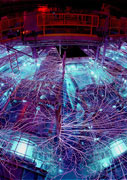Program on Science, Technology and Society at HarvardHarvard Kennedy School of Government | Harvard University |
||||||||
|
|

PublicationsThe following publications either directly resulted from the NSF project or draw heavily on its theoretical and empirical contributions: Sheila Jasanoff and Sang-Hyun Kim, eds. 2015. Dreamscapes of Modernity: Sociotechnical Imaginaries and the Fabrication of Power. Chicago, IL: University of Chicago Press. Dreamscapes of Modernity offers the first book-length treatment of sociotechnical imaginaries, a concept originated by Sheila Jasanoff and developed in close collaboration with Sang-Hyun Kim to describe how visions of scientific and technological progress carry with them implicit ideas about public purposes, collective futures, and the common good. The book presents a mix of case studies—including nuclear power in Austria, Chinese rice biotechnology, Korean stem cell research, the Indonesian Internet, US bioethics, global health, and more—to illustrate how the concept of sociotechnical imaginaries can lead to more sophisticated understandings of the national and transnational politics of science and technology. A theoretical introduction sets the stage for the contributors’ wide-ranging analyses, and a conclusion gathers and synthesizes their collective findings. The book marks a major theoretical advance for a concept that has been rapidly taken up across the social sciences and promises to become central to scholarship in science and technology studies. Project Team PublicationsSheila Jasanoff and Sang-Hyun Kim. 2009. “Containing the Atom: Sociotechnical Imaginaries and Nuclear Power in the United States and South Korea.” Minerva, 47 (2): 119-146. STS research has devoted relatively little attention to the promotion and reception of science and technology by non-scientific actors and institutions. One consequence is that the relationship of science and technology to political power has tended to remain undertheorized. This article aims to fill that gap by introducing the concept of ”sociotechnical imaginaries.” Through a comparative examination of the development and regulation of nuclear power in the US and South Korea, the article demonstrates the analytic potential of the imaginaries concept. Although nuclear power and nationhood have long been imagined together in both countries, the nature of those imaginations has remained strikingly different. In the US, the state’s central move was to present itself as a responsible regulator of a potentially runaway technology that demands effective ”containment.” In South Korea, the dominant imaginary was of ”atoms for development” which the state not only imported but incorporated into its scientific, technological and political practices. In turn, these disparate imaginaries have underwritten very different responses to a variety of nuclear shocks and challenges, such as Three Mile Island (TMI), Chernobyl, and the spread of the anti-nuclear movement. Sheila Jasanoff. May 2009. “Governing Innovation: The Social Contract and the Democratic Imagination.” Seminar 597. Sheila Jasanoff. March 2010. “A New Climate for Society.” Theory, Culture and Society, 27 (2-3): 233-253. This article argues that climate change produces discordances in established ways of understanding the human place in nature, and so offers unique challenges and opportunities for the interpretive social sciences. Scientific assessments such as those of the Intergovernmental Panel on Climate Change helped establish climate change as a global phenomenon, but in the process they detached knowledge from meaning. Climate facts arise from impersonal observation whereas meanings emerge from embedded experience. Climate science thus cuts against the grain of common sense and undermines existing social institutions and ethical commitments at four levels: communal, political, spatial and temporal. The article explores the tensions that arise when the impersonal, apolitical and universal imaginary of climate change projected by science comes into conflict with the subjective, situated and normative imaginations of human actors engaging with nature. It points to current environmental debates in which a reintegration of scientific representations of the climate with social responses to those representations is taking place. It suggests how the interpretive social sciences can foster a more complex understanding of humanity’s climate predicament. An important aim of this analysis is to offer a framework in which to think about the human and the social in a climate that seems to render obsolete important prior categories of solidarity and experience. Sheila Jasanoff, ed. 2011. Reframing Rights: Bioconstitutionalism in the Genetic Age. Cambridge, MA: MIT Press. This book contributes to the development of sociotechnical imaginaries by examining through a series of national and cross-national case studies how new biological descriptions of life have opened up new ways of imagining risks and benefits to human health, to familial and social relationships, to the state as it carries out its obligation to protect life, and to human nature itself. Legal texts have been with us since the dawn of human history. Beginning in 1953, life too became textual. The discovery of the structure of DNA made it possible to represent the basic matter of life with permutations and combinations of four letters of the alphabet, A, T, C, and G. Since then, the biological and legal conceptions of life have been in constant, mutually constitutive interplay—the former focusing on life’s definition, the latter on life’s entitlements. Reframing Rights argues that this period of transformative change in law and the life sciences should be considered “bioconstitutional.” Sheila Jasanoff maps out the conceptual territory in a substantive editorial introduction. Subsequently, the contributors offer “snapshots” of developments at the frontiers of biotechnology and the law. Chapters examine such topics as national cloning and xenotransplant policies; the politics of stem cell research in Britain, Germany, and Italy; DNA profiling and DNA databases in criminal law; clinical trials in India and the United States; the GM crop controversy in Britain; and precautionary policymaking in the European Union. These cases demonstrate changes of constitutional significance in the relations between human bodies, selves, science, and the state. James Benjamin Hurlbut. 2010. Experiments in Democracy: the Science, Politics and Ethics of Human Embryo Research in the United States, 1978-2007. Dissertation submitted to Harvard University, Department of the History of Science. Full dissertation (3MB PDF). This dissertation examines the scientific, ethical and political deliberations surrounding human embryo research in the United States from 1978 to 2007. During this thirty-year period, debates about the biological and moral status of the human embryo led to vigorous arguments about technology and the public good, about the forms of deliberation appropriate to public policy making, and about the tacit social contract between science and the state. The dissertation examines how a series of public bioethics bodies responded to scientific and technological developments from in vitro fertilization to human embryonic stem cell research. Each had to contend with the technical uncertainties of embryo research and with America’s moral pluralism; and each proposed a mode of public reasoning to resolve the tensions. I argue that each of these bodies accepted the notion that scientific knowledge stands outside of politics, but that they conceptualized the role of scientific authority differently because they varied in their conceptions of democracy. Debates over the definition of scientific terms like “preembryo” and “therapeutic cloning” were conducted simultaneously with arguments about whether the public was “confused” and whether such confusion should be corrected by experts or through democratic politics. I examine how these issues spilled over from ethics bodies into politics as states like California and Missouri became laboratories for new approaches to public support of biomedical research. By tracing the successive controversies that laid bare competing visions of democratic deliberation—from scientific technocracy to procedural pluralism, and from Rawlsian public reason to anti-Rawlsian communitarianism—the dissertation paints a dynamic picture of the co-production of science and politics. A central contention of the dissertation is that the ways in which science figured in politics—as a source of knowledge, as a wellspring of life-improving goods, and as a locus of rational and ostensibly extra-political authority—depended on the ideas of democracy that were advanced in parallel. Thus, the dissertation is at once a history of the human embryo as an object of laboratory research, of public and private institutions of biomedical research in America, and of the changing political role of public bioethics. Related PublicationsElta Smith. December 2009. “Imaginaries of Development: The Rockefeller Foundation and Rice Research.”Science as Culture, 18 (4): 461-482. This article is both a historical and contemporary analysis of the Rockefeller Foundation’s changing role in rice research over the past 50 years, and though there are many overlaps between them, focuses on three broad periods: first, the RF’s early work in rice research, particularly through the establishment of the International Rice Research Institute (IRRI) and the Green Revolution era of the 1960s and 1970s; second, the development of the RF’s rice biotechnology program in the 1980s; and third, the RF’s focus on agricultural research in Africa, with rice research as a subset of their programmatic efforts, during the 1990s and beyond. Rice research in each of the different periods was driven by different framings of problems and potential solutions, incorporating wider ideologies, epistemologies, and key actors and networks, with the RF at the center. Viewed in this way, the Rockefeller Foundation’s involvement in rice research cannot be seen ‘simply’ as an agricultural modernization project, but rather as simultaneously a sociopolitical project that extends particular modes of governance through homogenization and paternalism. Martyn Pickersgill. 2011. “Connecting Neuroscience and Law: Anticipatory Discourse and the Role of Sociotechnical Imaginaries.” New Genetics and Society 30(1): 27-40. In recent years, attempts have increasingly been made to connect neuroscience and law. Scientists and lawyers are imagining and actively fostering the realization of futures in which neuroscience will play a prominent role in the activity of courts. In this article I take these debates as my empirical object. I trace the emergence of neurolegal discourse, explore its focus on free will and lie detection, and show how expectations about the potential role neuroscience might play in the law are being embedded in new research programs and funding streams. In so doing, I analyze the role of particular “sociotechnical imaginaries” in stimulating, directing and restricting neurolegal discourse and highlight the ways in which new visions of law, science and scientists are produced in the process. Sociotechnical imaginaries are shown to be salient in structuring anticipatory discourse, and represent a key target for social scientific intervention in such debates. Les Levidow and Theo Papaioannou. (2013) State imaginaries of the public good: Shaping UK innovation priorities for bioenergy, Environmental Science and Policy 30: 36-49. Over the past decade UK government policy has been promoting bioenergy innovation in the name of the public good. This has been envisaged through sociotechnical imaginaries –feasible, desirable future visions dependent upon technoscientific advance. UK bioenergy has had three major imaginaries: localisation, agri-diversification and oil substitution. Through these imaginaries, technoscientific innovation is promoted as an essential means to gain societal benefits, to avoid harm and/or to overcome obstacles. Each imaginary combines specific models of environmental sustainability and economic advantage. These models arise from discursive resonances among research managers, government departments and other public-sector bodies. While such imaginaries have a decade-long history, they have been elaborated more persuasively for specific innovation pathways. Some linkages between imaginaries andinnovation pathways have been consolidated more strongly than others; key bodies have been convinced to provide a stronger policy commitment and material support. Warnings about unsustainable biomass have been discursively accommodated via prospects for future innovation which will enhance sustainability, alongside R&D funds to realise those prospects. Meanwhile bioenergy policy attempts to leave open future options which may generate more benefits. In such ways, UK bioenergy policy links epistemic claims for future sustainability with political authority for targets, subsidy and other incentives. Les Levidow. (2013) EU criteria for sustainable biofuels: Accounting for carbon, depoliticising plunder, Geoforum 44 (1): 211–223. The EU aspires to global leadership in developing ‘sustainable biofuels’ which can substitute for fossil fuels and thus reduce GHG emissions, while also enhancing energy security and rural development. Yet EU biofuel targets provide extra incentives for dispossessing rural communities in the global South, especially through land grabs and agro-industrial production methods. Since 2007 North–South NGO networks have denounced ‘agrofuels’ for such harm, thus provoking a high-profile controversy. Despite those criticisms, the 2009 Renewable Energy Directive (RED) set a mandatory target for European transport fuel to contain 10% renewable energy – in practical terms, meaning mainly biofuels by the 2020 deadline. In managing the consequent tensions, the EU system has elaborated a prior vision of a feasible,desirable future through sustainable biofuels. This combines several elements: mandatory targets incentivising investment in biofuels, R&D funds stimulating future novel biofuels, techniques commoditising natural resources in the name of protecting them, sustainability criteria homogenising the environment, and rural development models dependent on agro-industrial methods; those elements have become linked through circular reasoning. The EU’s political accountability is reduced to carbon accounting; in turn it is channelled into expert debates over modelling methods and uncertainties. Arguments about indirect land-use change (ILUC) became an implicit proxy for wider conflicts over the EU’s 10% target. Through the ILUC debate, biofuel critics have been drawn into expert procedures which obscure people’s experiences of harm in the global South. By these methods, the EU system can pursue global leadership for ‘sustainable biofuels’, while depoliticising its global plunder of resources. |
|||||||



